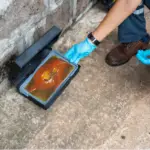Bucket rat traps are a popular method of controlling rat infestations. These traps are simple to make and can be very effective in catching rats.
The basic design of a bucket rat trap involves a bucket, a ramp, and bait. Rats are attracted to the bait and climb up the ramp to get to it.
Once they reach the bait, they fall into the bucket and are unable to climb out.
There are many different types of bucket rat traps available, each with its own unique design. Some of the most popular designs include the “Walk the Plank” and the “Rolling Log” varieties.
These traps use basic physics to trick rats into condemning themselves to the simple allure of food.
Some variations of bucket-style rat traps involve the use of water or poison to kill the rats, while others are designed to simply trap them alive so that they can be released elsewhere.
Regardless of the design, bucket rat traps can be an effective way to control rat infestations.

Table of Contents
What is Bucket Rat Traps?
Bucket rat traps are a type of trap that is designed to catch rats by luring them into a bucket and then trapping them inside.
These traps are typically made from a bucket, a piece of wood, and a trigger mechanism that causes the wood to fall when a rat steps on it.
Once the wood falls, the rat falls into the bucket and cannot escape.
Bucket rat traps are an effective way to catch rats, especially when used in conjunction with bait.
They are also relatively easy to make at home using simple materials, such as a 5-gallon bucket and some scrap wood.
One of the main advantages of bucket rat traps is that they are humane. Unlike some other types of traps, such as snap traps or glue traps, bucket rat traps do not kill the rats.
Instead, they simply trap them, allowing them to be released into the wild unharmed.
Another advantage of bucket rat traps is that they are reusable. Once a rat has been caught, the trap can simply be emptied and reset, making it a cost-effective and environmentally friendly option for rat control.
Overall, bucket rat traps are a simple and effective way to control rat populations.
While they may not be suitable for all situations, such as in areas where there is a risk of rats carrying disease, they can be a useful tool for homeowners and farmers looking to keep their property free from rats.
Prices pulled from the Amazon Product Advertising API on:
Product prices and availability are accurate as of the date/time indicated and are subject to change. Any price and availability information displayed on [relevant Amazon Site(s), as applicable] at the time of purchase will apply to the purchase of this product.
How do Bucket Rat Traps Work?
Bucket rat traps are a simple and effective way to catch rats. These traps work by using basic physics to trick rats into falling into a bucket of water or other liquid, where they will drown.
There are several different types of bucket rat traps, but they all work on the same basic principle.
The most common type of bucket rat trap is the “Walk the Plank” trap. This trap consists of a bucket filled with water, with a piece of wood or other material balanced on the edge of the bucket.
The wood extends out over the water, creating a ramp that the rat can climb up to reach the bait. Once the rat reaches the end of the ramp, the wood tilts and the rat falls into the water.
Another type of bucket rat trap is the “Rolling Log” trap. This trap consists of a bucket filled with water, with a rolling log or other cylindrical object suspended over the water.
The log is balanced on a wire or string that runs across the top of the bucket. When the rat tries to climb up to reach the bait, it will run into the log, which will spin and knock the rat into the water.
Bucket rat traps are effective because they take advantage of the rat’s natural behavior. Rats are curious and will investigate new objects in their environment.
When they see the bait on the trap, they will try to reach it, often ignoring the danger of the water below. Once they fall into the water, they are unable to climb out and will drown.
It is important to note that bucket rat traps should be used responsibly and with caution. They can be dangerous to other animals and should be placed in areas where they will not be accessed by pets or wildlife.
Additionally, it is important to dispose of trapped rats in a sanitary manner to prevent the spread of disease.
Advantages of Using Bucket Rat Traps
Bucket rat traps are a popular and effective way to control rats. They have several advantages over other types of traps and methods of rat control.
In this section, we will discuss the advantages of using bucket rat traps.
Eco-Friendly
Bucket rat traps are an eco-friendly way to control rats. They do not use any harmful chemicals or poisons that can harm the environment or other animals.
Bucket rat traps are also reusable, which means that they do not create any waste.
Cost-Effective
Bucket rat traps are a cost-effective way to control rats. They are inexpensive to make and can be made from materials that are readily available.
Bucket rat traps also do not require any ongoing costs, such as replacement baits or poisons.
Easy to Use
Bucket rat traps are easy to use. They do not require any special skills or knowledge to set up and use.
Bucket rat traps can be set up in a matter of minutes and are effective immediately. They also do not require any ongoing maintenance or cleaning.
In conclusion, bucket rat traps are an eco-friendly, cost-effective, and easy-to-use way to control rats. They have several advantages over other types of traps and methods of rat control.
Disadvantages of Using Bucket Rat Traps
Bucket rat traps are a popular and effective way to control rat infestations. However, they are not without their disadvantages.
In this section, we will discuss some of the drawbacks of using bucket rat traps.
Not Suitable for All Locations
Bucket rat traps are not suitable for all locations. They work best in areas where rats are known to travel, such as along walls, behind appliances, and in dark corners.
If rats are not present in these areas, the traps will not be effective.
Additionally, bucket rat traps are not suitable for outdoor use, as they can easily be knocked over by wind or rain.
Requires Frequent Checking
Bucket rat traps require frequent checking, as they need to be emptied and reset after each use. This can be time-consuming and may not be practical for those with busy schedules.
Additionally, if the traps are not checked regularly, rats may become trapped and die, leading to unpleasant odors and potential health hazards.
May Not Be Effective for Large Infestations
Bucket rat traps may not be effective for large infestations. If there are a large number of rats in an area, bucket rat traps may not be able to keep up with the demand.
Additionally, rats may become wary of the traps after seeing their companions become trapped, making it more difficult to catch them.
In conclusion, while bucket rat traps are an effective way to control rat infestations, they are not without their drawbacks.
They may not be suitable for all locations, require frequent checking, and may not be effective for large infestations.
It is important to consider these factors when deciding whether to use bucket rat traps for rat control.
How to Make a Bucket Rat Trap
If you are struggling with a rat infestation and want a humane way to catch them, a bucket rat trap is a great DIY solution.
The trap is simple to make and can be constructed using common household items.
In this section, we will provide step-by-step instructions on how to make a bucket rat trap.
Materials Needed
Before you begin building your bucket rat trap, you will need to gather the following materials:
- A 5-gallon bucket
- A wooden dowel or stick
- A piece of cardboard or thin wood
- Peanut butter or other bait
- Water
Step-by-Step Instructions
- Start by drilling two holes on opposite sides of the bucket, about 3 inches below the rim. The holes should be large enough to fit the wooden dowel or stick.
- Cut the cardboard or thin wood into a rectangular shape that will fit across the top of the bucket. Then, cut a small notch in the center of the cardboard that is wide enough to fit the dowel or stick.
- Smear some peanut butter or other bait on the cardboard, making sure to cover the notch.
- Fill the bucket with about 3 inches of water.
- Place the cardboard on top of the bucket, with the dowel or stick resting on the holes you drilled earlier.
- Wait for the rats to take the bait. When they step on the cardboard to reach the bait, it will tip over, sending the rat into the water below.
- Check the trap regularly and dispose of any rats that you catch.
With these simple steps, you can easily make your own bucket rat trap. It is an effective and humane way to deal with a rat infestation, and it can be made using items you likely already have around your home.
Tips for Using Bucket Rat Traps
When it comes to trapping rats, bucket traps are an effective and affordable option. By following a few tips, you can increase your chances of catching these pesky rodents.
Placement
The placement of the bucket trap is crucial for its effectiveness. It is important to place the trap in the areas where rats are most active. This could be near their burrows, along walls, or near food sources.
It is also important to ensure that the trap is stable and won’t tip over easily. You can place a heavy object on top of the trap to prevent it from moving or falling.
Bait
Choosing the right bait is essential for attracting rats to the trap. Peanut butter is a popular choice as it has a strong smell that rats find irresistible. Other options include bacon, cheese, and dried fruit.
When baiting the trap, it is important to use enough to entice the rat to enter the trap but not too much that it can easily grab the bait and escape without triggering the trap.
Maintenance
Checking the trap regularly is important to ensure its effectiveness. If a rat is caught, it is important to dispose of it properly and reset the trap with fresh bait.
It is also important to clean the trap after each use to prevent the spread of disease and to remove any lingering odors that may deter rats from entering the trap.
By following these tips, you can increase your chances of catching rats with a bucket trap. Remember to always handle traps with care and dispose of rats properly to prevent the spread of disease.
Conclusion
In conclusion, bucket rat traps offer a simple and effective solution for rodent control. These traps provide a cost-effective and environmentally friendly alternative to traditional methods, such as toxic chemicals or expensive exterminators.
The design of the bucket rat trap is straightforward, utilizing a basic bucket, a wooden plank, and some bait to lure rodents into the trap.
Once inside, the rats or mice fall into the bucket and are unable to escape.
This method is not only efficient but also humane, as it does not involve the use of harmful substances or cause unnecessary suffering to the pests.
One of the key advantages of bucket rat traps is their accessibility and ease of use. They can be easily constructed with readily available materials found in most households or obtained at low cost.
Setting up the trap requires minimal effort and does not require specialized knowledge or skills.
Moreover, bucket rat traps can be placed in various locations both indoors and outdoors, allowing for effective control of rodents in different environments.
Overall, bucket rat traps are a simple, cost-effective, and efficient solution for rodent control. They offer an accessible and environmentally friendly method to effectively manage rodent infestations in both residential and commercial settings.
By employing these traps alongside other preventive measures, individuals can successfully combat rodent problems while promoting a safe and healthy environment.
- How to Build a Planter Box for Bamboo: A Step-by-Step Guide

- Can Robotic Lawnmowers Handle Steep Slopes?

- Do You Need a Specific Lawn for a Robotic Lawnmower? Expert Advice

- Are Robotic Lawnmowers Safe for Pets and Children? Safety Features of Robotic Lawnmowers

- Why Use Robotic Lawnmowers? Advantages of Using a Robotic Lawnmower

- Is the GARDENA SILENO City 300 Cordless or Corded? A Clear Answer




















